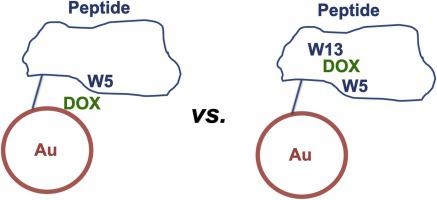Colloids and Surfaces B: Biointerfaces ( IF 5.8 ) Pub Date : 2020-05-28 , DOI: 10.1016/j.colsurfb.2020.111155 Kai S Exner 1 , Anela Ivanova 1

|
Efficient drug delivery to malignant cells in the human organism requires the application of drug-delivery systems (DDS) that consist of several building blocks, such as a biomolecule to bind the drug as well as a carrier for transport. In the present study, we investigate a potential DDS component for the cytostatic doxorubicin (DOX) that consists of a gold nanoparticle (Au-NP) and a short drug-binding peptide sequence. Combining molecular dynamics simulations with density functional theory calculations allows resolving the adsorption configurations of DOX at simulated physiological conditions as well as the interaction energies between the building blocks of the DDS. Interestingly, it turns out that the task of the Au-NP is not limited to being a passive carrier. The nanoparticle is directly involved in the stabilization of the drug by intercalating DOX together with a tryptophan residue from the peptide. Another favored adsorption configuration corresponds to an intercalation complex of DOX with two tryptophan residues, reminiscent of the intercalation of DOX between DNA bases. The insights gained in the present study allow deriving general conclusions about the surface chemistry of DOX: its tendency to intercalate seems not to depend on its π-stacking partners (organic or inorganic), as long as they can be properly arranged around the drug. Hence, DOX may be stabilized sufficiently during its delivery if intercalation within the carrier moieties is possible. This finding may assist the construction of a more complex DDS for DOX in the future, for which the investigated drug-peptide-nanoparticle conjugate may serve as a prototype.
中文翻译:

确定金纳米颗粒作为用于运输阿霉素-肽复合物的主动载体。
有效地将药物输送到人体内的恶性细胞需要应用药物输送系统(DDS),该系统由几个构件组成,例如与药物结合的生物分子以及用于运输的载体。在本研究中,我们研究了细胞抑制性阿霉素(DOX)的潜在DDS成分,该成分由金纳米颗粒(Au-NP)和短的药物结合肽序列组成。将分子动力学模拟与密度泛函理论计算相结合,可以解决DOX在模拟生理条件下的吸附构型以及DDS结构单元之间的相互作用能。有趣的是,事实证明,Au-NP的任务不仅限于作为被动载体。纳米颗粒通过将DOX与肽中的色氨酸残基一起插入而直接参与药物的稳定化。另一有利的吸附构型对应于具有两个色氨酸残基的DOX的嵌入复合物,让人联想到DNA碱基之间的DOX的嵌入。在本研究中获得的见解可以得出关于DOX表面化学的一般结论:只要能够在药物周围适当地排列,其插入的趋势似乎就不取决于其π堆积伴侣(有机或无机)。因此,如果可能在载体部分内插入,则DOX在其递送期间可以充分稳定。这一发现可能有助于将来为DOX构建更复杂的DDS,



























 京公网安备 11010802027423号
京公网安备 11010802027423号